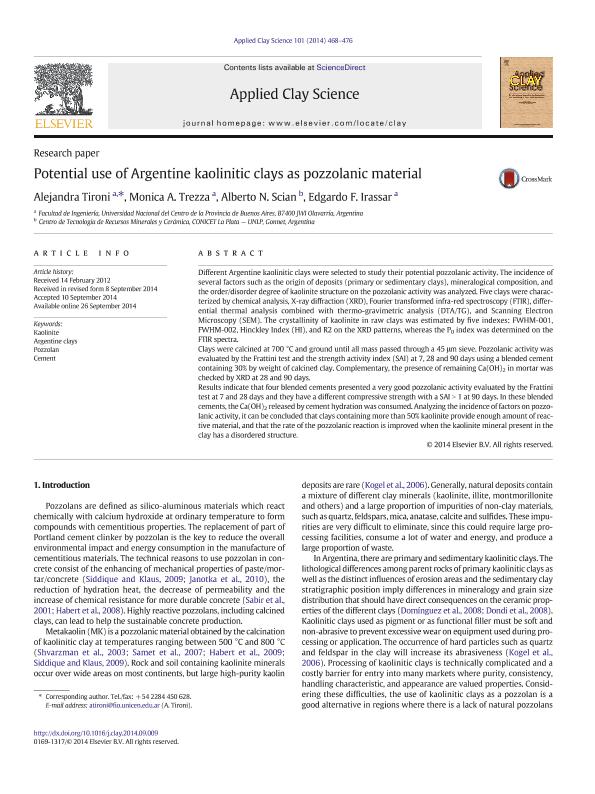Mostrar el registro sencillo del ítem
dc.contributor.author
Tironi, Alejandra

dc.contributor.author
Trezza, Mónica Adriana

dc.contributor.author
Scian, Alberto Nestor

dc.contributor.author
Irassar, Edgardo Fabián

dc.date.available
2017-01-13T18:12:26Z
dc.date.issued
2014-11
dc.identifier.citation
Tironi, Alejandra; Trezza, Mónica Adriana; Scian, Alberto Nestor; Irassar, Edgardo Fabián; Potential use of Argentine kaolinite clays as pozzolanic material; Elsevier Science; Applied Clay Science; 101; 11-2014; 468-476
dc.identifier.issn
0169-1317
dc.identifier.uri
http://hdl.handle.net/11336/11310
dc.description.abstract
Different Argentine kaolinitic clays were selected to study their potential pozzolanic activity. The incidence of several factors such as the origin of deposits (primary or sedimentary clays), mineralogical composition, and the order/disorder degree of kaolinite structure on the pozzolanic activity was analyzed. Five clays were characterized by chemical analysis, X-ray diffraction (XRD), Fourier transformed infra-red spectroscopy (FTIR), differential thermal analysis combined with thermo-gravimetric analysis (DTA/TG), and Scanning Electron Microscopy (SEM). The crystallinity of kaolinite in raw clays was estimated by five indexes: FWHM-001, FWHM-002, Hinckley Index (HI), and R2 on the XRD patterns, whereas the P0 index was determined on the FTIR spectra. Clays were calcined at 700 °C and ground until all mass passed through a 45 μm sieve. Pozzolanic activity was evaluated by the Frattini test and the strength activity index (SAI) at 7, 28 and 90 days using a blended cement containing 30% by weight of calcined clay. Complementary, the presence of remaining Ca(OH)2 in mortar was checked by XRD at 28 and 90 days. Results indicate that four blended cements presented a very good pozzolanic activity evaluated by the Frattini test at 7 and 28 days and they have a Different compressive strength with a SAI N 1 at 90 days. In these blended cements, the Ca(OH)2 released by cement hydrationwas consumed. Analyzing the incidence of factors on pozzolanic activity, it can be concluded that clays containingmore than 50% kaolinite provide enough amount of reactive material, and that the rate of the pozzolanic reaction is improved when the kaolinite mineral present in the clay has a disordered structure.
dc.format
application/pdf
dc.language.iso
eng
dc.publisher
Elsevier Science

dc.rights
info:eu-repo/semantics/openAccess
dc.rights.uri
https://creativecommons.org/licenses/by-nc-nd/2.5/ar/
dc.subject
Kaolinite
dc.subject
Argentine Clays
dc.subject
Pozzolan
dc.subject
Cement
dc.subject.classification
Cerámicos

dc.subject.classification
Ingeniería de los Materiales

dc.subject.classification
INGENIERÍAS Y TECNOLOGÍAS

dc.title
Potential use of Argentine kaolinite clays as pozzolanic material
dc.type
info:eu-repo/semantics/article
dc.type
info:ar-repo/semantics/artículo
dc.type
info:eu-repo/semantics/publishedVersion
dc.date.updated
2016-11-23T19:57:43Z
dc.journal.volume
101
dc.journal.pagination
468-476
dc.journal.pais
Países Bajos

dc.journal.ciudad
Amsterdam
dc.description.fil
Fil: Tironi, Alejandra. Universidad Nacional del Centro de la Provincia de Buenos Aires. Facultad de Ingenieria de Olavarria; Argentina. Consejo Nacional de Investigaciones Científicas y Técnicas. Centro Científico Tecnológico Tandil; Argentina
dc.description.fil
Fil: Trezza, Mónica Adriana. Universidad Nacional del Centro de la Provincia de Buenos Aires. Facultad de Ingenieria Olavarria; Argentina
dc.description.fil
Fil: Scian, Alberto Nestor. Consejo Nacional de Investigaciones Científicas y Técnicas. Centro Científico Tecnológico La Plata. Centro Tecnológico de Recursos Minerales y Cerámica (i); Argentina
dc.description.fil
Fil: Irassar, Edgardo Fabián. Universidad Nacional del Centro de la Provincia de Buenos Aires; Argentina
dc.journal.title
Applied Clay Science

dc.relation.alternativeid
info:eu-repo/semantics/altIdentifier/url/http://www.sciencedirect.com/science/article/pii/S0169131714003524
dc.relation.alternativeid
info:eu-repo/semantics/altIdentifier/doi/http://dx.doi.org/ 10.1016/j.clay.2014.09.009
Archivos asociados
